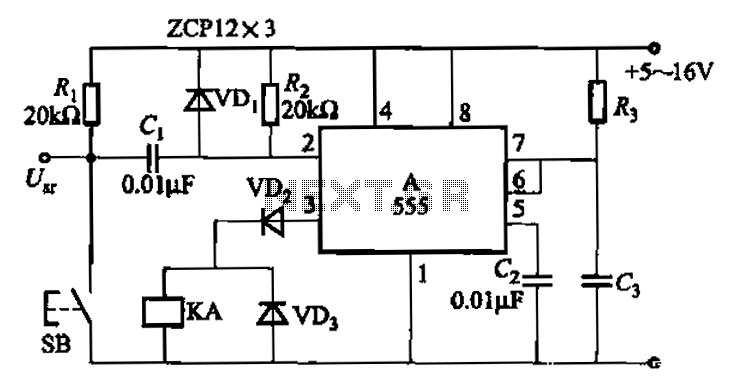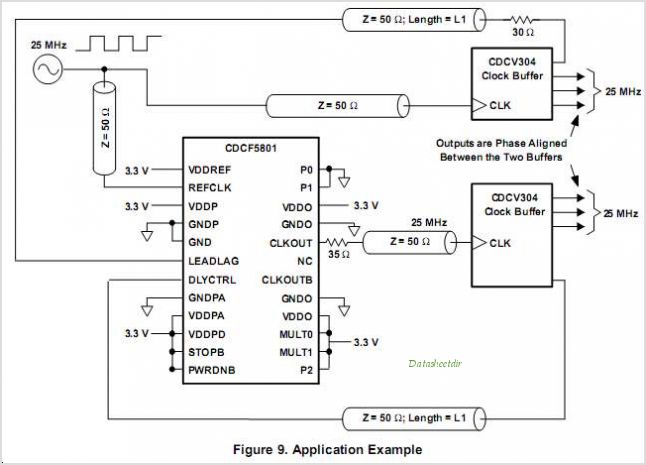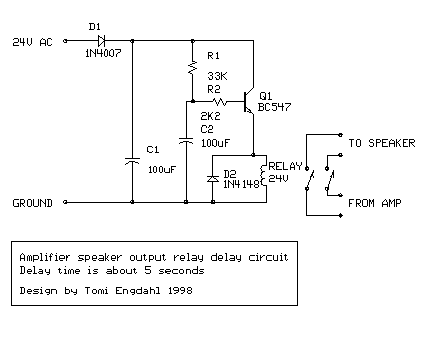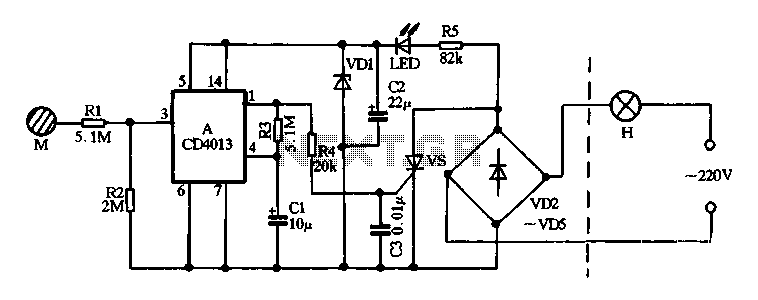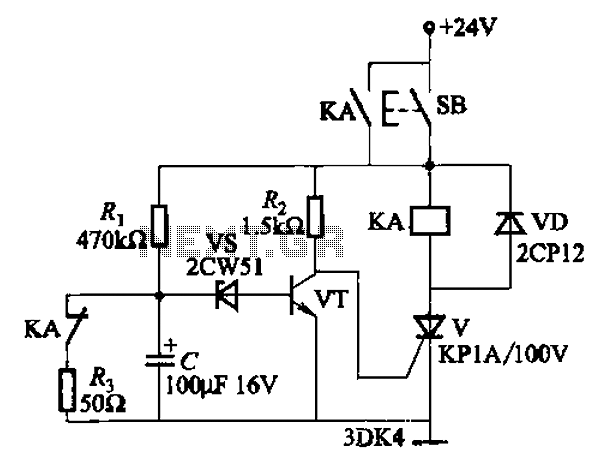
Long Delay TimerCircuit
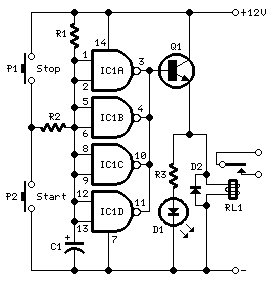
This timer was designed primarily to switch off a portable radio after a set period. This feature allows users to fall asleep on the beach or in a hammock, knowing that the receiver will automatically turn off after a specified time, thus conserving battery power. Resistor R1 and capacitor C1 create a long time constant. When switch P2 is briefly closed, capacitor C1 discharges, causing a near-zero voltage at its positive lead, which is then applied to the high-impedance inputs of the four gates of integrated circuit IC1, configured in parallel. As a result, the outputs of the four gates go high, allowing battery voltage to reach the emitter of transistor Q1. Upon releasing switch P2, capacitor C1 begins to charge slowly through resistor R1. Once the voltage at C1's positive lead reaches approximately half the battery voltage, the outputs of the IC gates drop to zero, turning off Q1. This transistor can directly drive a portable radio receiver or other devices with current requirements up to about 250 mA. By connecting a relay across the emitter of Q1 and the negative ground, devices needing higher voltage and current can be controlled through the relay contacts. Pressing switch P2 for 1 to 5 seconds activates the circuit, which will then turn off after approximately 35 minutes. The time delay can be adjusted by modifying the values of R1 and/or C1. Switch P1 can be used to stop the timer if necessary. A 4011 Quad 2-Input NAND Gate is utilized for IC1, but other CMOS gates or inverter arrays, such as 4001, 4002, 4025, 4012, 4023, 4049, and 4069, can also be employed. When using these alternative devices, all inputs and outputs must be interconnected as indicated in the circuit diagram.
The timer circuit is an effective solution for automatic shut-off applications, particularly for battery-operated devices like portable radios. The design leverages the charging and discharging characteristics of the capacitor C1, combined with the resistive path provided by R1, to create a time delay that can be fine-tuned for specific needs. The use of a quad NAND gate IC allows for a compact arrangement of logic gates, which simplifies the circuit and reduces component count.
In operation, when P2 is pressed, the initial discharge of C1 ensures that the logic gates receive a low signal, prompting them to output a high signal that activates Q1. This transistor acts as a switch, allowing current to flow to the connected device, such as a radio. The gradual charging of C1 through R1 means that the voltage across C1 will rise slowly, providing a predictable time delay before the gates revert to a low state, which in turn turns off Q1.
The capability to control higher current devices through a relay adds versatility to the design. By incorporating a relay, the circuit can manage appliances that exceed the direct current rating of Q1, expanding the potential applications of the timer circuit. The adjustment of R1 and C1 values allows users to customize the shut-off time, making it suitable for various scenarios, from short naps to longer periods of inactivity.
The inclusion of a manual stop switch (P1) provides an additional layer of control, allowing the user to terminate the timer function at any point, enhancing the circuit's usability. Overall, this timer circuit exemplifies a practical and efficient approach to managing power consumption in portable electronic devices.This timer was designed mainly to switch off a portable radio after some time: in this way, one can fall asleep on the sand or on a hammock, resting assured that the receiver will switch off automatically after some time, saving battery costs. R1 and C1 provide a very long time constant. When P2 is momentarily closed, C1 discharges and the near ze ro voltage at its positive lead is applied to the high impedance inputs of the four gates of IC1 wired in parallel. The four paralleled gate outputs of the IC go therefore to the high state and the battery voltage is available at Q1 Emitter.
When P2 is released, C1 starts charging slowly through R1 and when the voltage at its positive lead has reached about half the battery voltage, the IC gate outputs fall to zero, stopping Q1. This transistor can directly drive a portable radio receiver or different devices drawing a current up to about 250mA.
Connecting a Relay across the Emitter of Q1 and negative ground, devices requiring much higher voltage and current operation can be driven through its contacts. Pushing on P2 for 1 to 5 seconds, the circuit starts and then will switch off after about 35 minutes.
This time delay can be varied by changing R1 and/or C1 values. P1 will stop the timer if required. A 4011 Quad 2 Input NAND Gate was used for IC1, but many other CMos gates or inverter arrays can be used in its place, e. g. 4001, 4002, 4025, 4012, 4023, 4049, 4069. With these devices, all inputs must be tied together and also all outputs, as shown in the Circuit diagram.
🔗 External reference
The timer circuit is an effective solution for automatic shut-off applications, particularly for battery-operated devices like portable radios. The design leverages the charging and discharging characteristics of the capacitor C1, combined with the resistive path provided by R1, to create a time delay that can be fine-tuned for specific needs. The use of a quad NAND gate IC allows for a compact arrangement of logic gates, which simplifies the circuit and reduces component count.
In operation, when P2 is pressed, the initial discharge of C1 ensures that the logic gates receive a low signal, prompting them to output a high signal that activates Q1. This transistor acts as a switch, allowing current to flow to the connected device, such as a radio. The gradual charging of C1 through R1 means that the voltage across C1 will rise slowly, providing a predictable time delay before the gates revert to a low state, which in turn turns off Q1.
The capability to control higher current devices through a relay adds versatility to the design. By incorporating a relay, the circuit can manage appliances that exceed the direct current rating of Q1, expanding the potential applications of the timer circuit. The adjustment of R1 and C1 values allows users to customize the shut-off time, making it suitable for various scenarios, from short naps to longer periods of inactivity.
The inclusion of a manual stop switch (P1) provides an additional layer of control, allowing the user to terminate the timer function at any point, enhancing the circuit's usability. Overall, this timer circuit exemplifies a practical and efficient approach to managing power consumption in portable electronic devices.This timer was designed mainly to switch off a portable radio after some time: in this way, one can fall asleep on the sand or on a hammock, resting assured that the receiver will switch off automatically after some time, saving battery costs. R1 and C1 provide a very long time constant. When P2 is momentarily closed, C1 discharges and the near ze ro voltage at its positive lead is applied to the high impedance inputs of the four gates of IC1 wired in parallel. The four paralleled gate outputs of the IC go therefore to the high state and the battery voltage is available at Q1 Emitter.
When P2 is released, C1 starts charging slowly through R1 and when the voltage at its positive lead has reached about half the battery voltage, the IC gate outputs fall to zero, stopping Q1. This transistor can directly drive a portable radio receiver or different devices drawing a current up to about 250mA.
Connecting a Relay across the Emitter of Q1 and negative ground, devices requiring much higher voltage and current operation can be driven through its contacts. Pushing on P2 for 1 to 5 seconds, the circuit starts and then will switch off after about 35 minutes.
This time delay can be varied by changing R1 and/or C1 values. P1 will stop the timer if required. A 4011 Quad 2 Input NAND Gate was used for IC1, but many other CMos gates or inverter arrays can be used in its place, e. g. 4001, 4002, 4025, 4012, 4023, 4049, 4069. With these devices, all inputs must be tied together and also all outputs, as shown in the Circuit diagram.
🔗 External reference
Warning: include(partials/cookie-banner.php): Failed to open stream: Permission denied in /var/www/html/nextgr/view-circuit.php on line 713
Warning: include(): Failed opening 'partials/cookie-banner.php' for inclusion (include_path='.:/usr/share/php') in /var/www/html/nextgr/view-circuit.php on line 713
